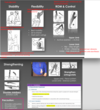L9d: Exercise Prescription for Neurological Groups Flashcards
(18 cards)
Older people more likely to experience a ____ due to ↑ prevalence of cardiovascular & metabolic diseases with age
stroke
Physiotherapy ____ focuses on improving movement and function by way of addressing underlying complications
rehabilitation
What are 5 characteristics for exercise for stroke patients to help patients to regain independent living ?
- Strengthening
- Stretching
- Which have become tight due to spasticity or contractures
- Stabilising
- Balance & Gait
- Task-specific training
What are 4 characteristics for stroke rehabilitation?
- Stability
- Flexibility
- ROM and control
- Strengthening

What are the choice of exercise determined by?
Stage and severity of stroke
Initially use
- Resistance provided by gravity
- Progression to therabands –> Free weights
Upper extremity _____ (increased resistance to passive movements) commonly observed (_____)
- Elbow flexors
- Adductors
Thus, strengthening of antagonistic muscles (eg. triceps) is need to alleviate this complication and also stretch out the agonists (biceps)
flexors; spasticity
This same principle can be applied to the lower extremity, however the pattern of spasticity is characterised by ____ (flexors/extensors) rather than ______(flexors/extensors)
extensors; flexor
What are 3 characteristics for patients with shoulder subluxation or pain?
- Arm must be supported at all times (Before, during and after treatment)
- Can use some strapping position
- Important to have the patient in a supported position after treatment session
What is task specific training?

What are 4 examples of exercise to challenge balance?
- Balance performance in both sitting and standing are key elements
- Reaching for objects beyond arms length (move Com towards limits of BOS)
- Initially require a lot of support and encouragement
- Once regain balance control –> this will slowly be reduced
- Task specific for UL reaching, grasping, dressing
- Task specific for LL- walking, stepping
Often task needs to broken up into individual components before combining for neurological groups. What are 4 steps in sit to stand manoeuvre?
- Moving feet back before attempting to rise
- Forward trunk flexion
- Pushing up through lower limbs
- Once in a standing position –> maintaining the upright stance
How can providing cues and feedback uses to facilitated correct postural alignment and movement patterns for neurological groups?
- Sensory
- Proprioceptive
What are movement disorders?

What are 3 movements to work on for PD?
- Rigidity
- Reduced ROM
- Strengthening muscles = smooth and controlled movements
What are 4 things to help prevent Deterioration of functional tasks performance as the disease progresses?
- Reaching and grasping
- Bed mobility
- Sit to stand
- Gait
To help with movement initiation (which gets impaired with this disease), what are 4 aids?
- Use hearing techniques (auditory cues)
- Giving commands to step while walking
- Have the patient step in time to a metronome or clap
- Cognitive
- Memorise and repeat instructions to themselves
- Tactile
- Hand placement
- Visual
- Mirrors (observe and correct their own movement)
- Step out to markers on the ground to encourage longer step length
_____ re-training and falls prevention plays a massive role in prescription in PD
Balance
What can help with balance training for PD patients?
- Use same balance exercises as we would for general ageing population and those prone to falling
- Need to consider the additional use of hearing techniques and help with tremor and rigidity
- Could effect performance or any training effects


